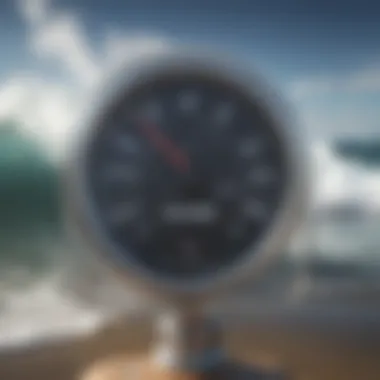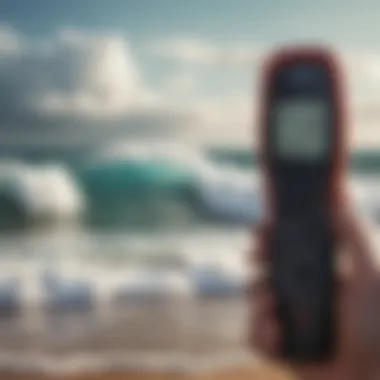Exploring Wind Measurement Tools for Surfers


Intro
Surfing is more than just riding waves; it’s a meticulous dance between the surfer and nature's forces, especially the wind. Many surfers often underestimate the wind's role in shaping their surf experience. Understanding wind measurement instruments is not just a nice-to-have—it’s a game-changer for enhancing safety and performance on the surf.
This article takes a thorough look at the tools geared toward accurately measuring wind, exploring handheld anemometers to comprehensive weather stations. With this knowledge in hand, surfers can make informed decisions before hitting the waves. Let’s dive in and see how wind data can turn a mediocre surf day into an unforgettable ride.
Techniques and Skills
Surfing requires not just the right moves but the proper conditions to execute them. With wind measurements at the forefront, surfers can master the art of wave riding. Here we elucidate some fundamentals that underscore the importance of wind in surfboarding.
Wave Riding Essentials
The science of wave riding is intricately tied to wind conditions. For starters, the direction and speed of the wind can greatly influence wave formation. A light onshore wind can create mushy waves, while a strong offshore wind can groom them into perfect, well-defined barrels.
To grasp these concepts better, consider these key points:
- Onshore Wind: Usually common, it pushes waves towards the shore, causing them to break earlier. This can result in softer, less powerful rides.
- Offshore Wind: Blowing from land to sea, this kind of wind can create cleaner, more powerful waves as it holds them up longer.
- Side Shore Wind: It can create choppy waters, making for a more turbulent ride and often complicating maneuvers.
By paying attention to these wind patterns, surfers can not only select the right conditions but also improve their technique.
Advanced Maneuvers and Tricks
Once the surfers have mastered the basics, they might look to push their limits with advanced tricks. But without understanding the wind's role, these maneuvers can fall flat.
For instance, aerial maneuvers require precise timing and positioning, often dictated by wind conditions. Surfers attempting to go airborne need to be aware of:
- Wind Speed: A stiffer breeze can help lift the board higher off the wave.
- Wave Shape: Peaking waves driven by offshore winds can offer a solid launching pad.
- Body Positioning: Knowing how to position oneself as the wind fills the sails—figuratively speaking—can lead to spectacular feats.
By understanding these factors, surfers can enhance their repertoire, landing those crowd-pleasing stunts while ensuring safety.
Equipment and Gear
Wind measurement is only half the battle; knowing how to pair your surfing with the right gear is equally vital. Here are some essential tools and accessories that can make a substantial difference in surfboarding experience.
Wind Measurement Devices
Investing in wind measurement tools is essential for both novice and experienced surfers. Here’s a brief overview of some devices:
- Handheld Anemometers: Portable and user-friendly, they provide real-time wind speed data, helpful for quick assessments before surf sessions.
- Kitesurf Weather Stations: More advanced setups can measure a variety of factors, including wind direction, humidity, and air pressure. Perfect for seasoned surfers looking for comprehensive data.
- Smartphone Apps: Many users rely on weather apps, which combine various data sources to offer a broad overview. While not as precise as a dedicated device, they are convenient and accessible.
Essential Accessories for Every Surfer
The right accessories can elevate any surf experience. Consider these:
- Wetsuits: Protect against chillier winds and keep body heat regulated.
- Leashes: Essential for safety; they keep the board close during wipeouts.
- Surfboard Wax: Helps maintain grip, especially when winds are strong and unruly.
"Understanding wind can turn average surf conditions into something special."
By utilizing a solid mix of these tools and gear, surfers not only sharpen their skills but significantly increase their safety and enjoyment.
The End
In the world of surfing, wind measurement instruments hold immense significance. They not only influence wave conditions but also enhance one’s ability to perform at all levels. By leveraging this knowledge, surfers can make informed decisions, ensuring they maximize their time on the water. Understanding how these elements work together is the key to mastery in the surf—an endeavor to ride every wave with confidence.
Prelims to Wind Measurement Instruments
Understanding the tools that measure wind is vital for surfers. Why? Because wind affects the waves, the paddling conditions, and even the overall experience in the water. Accurate data on wind speed and direction can lead to better decision making, especially when choosing the optimal time to surf. For enthusiasts, retailers, and instructors alike, having this knowledge translates into improved safety and performance, making wind measurement instruments critical to the sport.
You might be wondering what these instruments really do. They not only provide data about current conditions but can also help you anticipate changes. As the saying goes, "forewarned is forearmed." Knowing when a storm is brewing or when the wind changes direction can be the difference between riding perfect waves and getting stuck with choppy conditions.
In this article, we will break down the various types of wind measurement tools commonly used in surfboarding. Whether you’re an inexperienced surfer hoping to carve your first wave or an old salt looking for the next big swell, understanding these instruments will deepen your appreciation for the art of surfing.


The Importance of Wind in Surfboarding
Wind plays a substantial role in determining surf conditions. It affects the shape of waves, how they break, and even how long they last. Offshore winds can clean up waves, giving them that glassy appearance that surfers crave. Conversely, onshore winds often lead to choppy water and less desirable surf. In short, understanding wind direction and speed is like having a map to the best spots.
Consider this: if the wind is blowing at a steady 15 knots offshore, seasoned surfers will know to pack up their boards and hit the water pronto. Not only does it create favorable wave conditions, but it also allows for better control while navigating the surf. On the flip side, a sudden shift to onshore can spell trouble, causing a swell to misbehave.
In essence, recognizing how wind influences the ocean can help surfers make informed choices, enhancing both the joy and safety of the sport.
Types of Wind Measurement Instruments
There’s a smorgasbord of tools available for measuring wind, each with its own set of features and applications. From handheld devices that fit in your pocket to sophisticated meteorological stations, the variety can be overwhelming. But understanding what’s available simplifies the selection process.
Common Instruments:
- Anemometers: These devices gauge wind speed and sometimes direction. They come in various types—some are handheld for portability, while others are fixed installations that provide more thorough data over time.
- Wind Vanes: Simple yet effective, these instruments indicate wind direction. They can be standalone units or integrated into other systems.
By understanding these tools, surfers can choose the best fit for their needs, turning heads and catching waves with unmatched prowess.
Basic Instruments for Wind Measurement
Wind measurement instruments play a crucial role in surfboarding. They provide essential data that helps surfers choose the right time and place to ride the waves. Without accurate wind information, surfers could be caught off guard, potentially leading to less enjoyable sessions or even dangerous situations. Understanding the basic instruments available for measuring wind is paramount for any surfboard enthusiast, as these tools help optimize performance and improve safety on the water.
Anemometers
Definition and Functionality
An anemometer is a device that measures wind speed and sometimes wind direction. Its functionality is simple yet profound, serving as a lifeline for surfers eager to ride the best waves. The key characteristic of an anemometer is its ability to provide real-time data. This immediacy helps surfers make on-the-spot decisions about whether to hit the water or wait for better conditions.
A unique feature of anemometers is their ability to deliver various measurements, such as maximum gust speed and average wind over time. This information could make a massive difference in a surfer's experience. However, it’s worth noting that some models require calibration and might not always be spot-on without proper maintenance.
Types of Anemometers
There are several types of anemometers, each tailored for specific applications. Cup anemometers, for instance, use rotating cups to measure wind speed. Their simplicity and durability make them a popular choice among surfers looking for straightforward data without much fluff. On the other hand, digital anemometers offer more advanced functionalities, such as data logging, which can be invaluable for serious surfers aiming to monitor conditions over time.
The variety in types allows surfers to select an anemometer best suited to their needs, balancing aspects like portability and measurement precision. However, it is essential to mention that some digital models might not hold up as well in extreme conditions, which surfers often face.
Portable Anemometers for Surfers
For the on-the-go surfer, portable anemometers are a game changer. These handheld devices are convenient to carry, lightweight, and often come equipped with useful features like backlit displays and memory functions. The key advantage of portable anemometers is their immediacy, allowing surfers to get a quick reading right on the beach before they jump into the water.
One unique aspect of many portable anemometers is their ability to measure wind chill and how it combines with wind speed, giving valuable data about surf conditions that could impact a surfer's comfort and decision-making. Nevertheless, while portability is a bonus, these devices may sacrifice some measurement range compared to larger, fixed installations.
Wind Vanes
Design Features
Wind vanes are additional tools that surfers can use to gauge wind direction—a vital element influencing wave formation and surfing conditions. The design of a wind vane is straightforward, typically featuring an arrow mounted on a pivot, allowing it to spin freely. This design enables quick assessments of wind direction, helping surfers choose the right spot on the beach.
The main characteristic that stands out with wind vanes is their simplicity. They are usually low maintenance and do not require elaborate installations, making them accessible to surfers of all skill levels. They might not provide wind speed data, but they excel at offering immediate directional information, thus filling a critical gap in a surfer's toolkit.
Usage in Surf Conditions
When it comes to using wind vanes in surf conditions, their contribution is significant. Wind direction can drastically impact waves. For instance, offshore winds can create clean and manageable surf, whereas onshore winds might lead to choppier conditions. Surfers can use the directional data provided by a wind vane to determine when and where to paddle out for the best ride.
One notable feature is their affordability; unlike high-end anemometers, wind vanes are often inexpensive and can be purchased by anyone interested in surfing. On the flip side, they may not be equipped with digital functionalities, which can limit their usability in data-driven discussions about surf conditions.
"Understanding the subtleties of wind behavior is just as crucial as mastering the waves; it's all about reading the signs right before you dive in."
Overall, both anemometers and wind vanes serve fundamental roles in enhancing the surf experience through better wind measurement. Armed with these instruments, surfers can make informed choices, ensuring a safer and more exhilarating time on the water.
Advanced Wind Measurement Technologies


Wind measurement has come a long way, especially with the rapid advancements in technology. For surfers, understanding these advanced wind measurement technologies is crucial. They offer real-time data that can significantly enhance the surf experience by making it more enjoyable and safer. Surfers no longer have to solely rely on outdated methods; technology equips them with tools that provide precise wind readings, which are key to planning the best surf sessions.
Meteorological Stations
Meteorological stations are like the watchtowers of the oceanic environment. These systems are designed to collect extensive data on various atmospheric conditions, including wind speed and direction. The depth of information they offer is unmatched, making them an invaluable resource for surfers who want to optimize their sessions.
Components of a Meteorological Station
A typical meteorological station includes several key components that make it a comprehensive tool for data collection. These features often comprise:
- Anemometers for measuring wind speed.
- Wind vanes for determining wind direction.
- Barometers to check atmospheric pressure.
- Hygrometers for humidity levels.
The potency of these components lies in their ability to provide surfers with an integrative view of the surfing conditions. By utilizing multiple instruments, they gather a holistic snapshot of the environment. What makes meteorological stations particularly appealing is their ability to deliver data over expansive areas. However, they can be a bit pricey and often require maintenance, which can deter some surfers from using them regularly.
Data Collection Processes
The data collection processes of meteorological stations are remarkable. They often operate on automatic systems that continuously monitor and record atmospheric conditions. Every variable plays a part:
- Real-time monitoring allows surfers to react faster than ever before.
- Data transmission systems like Wi-Fi or cellular networks make it easy to access information from anywhere.
- Quality control in data collection ensures that the transmitted data is reliable and useful.
The reliability of this data is a crucial feature because it supports decision-making in surfboarding. Surfers can make informed choices based on the accurate and timely data received. However, there’s a notable downside; variations in geographical location can affect the precision of the data. Hence, surfers should be wary when depending wholly on any one meteorological station, always cross-referencing other sources when possible.
Mobile Weather Apps and Their Impact
Enter the world of mobile weather apps—a game changer for many surfers. These apps have made the once complex task of gathering wind data, a breeze. Their benefits are far-reaching, especially in a sport where conditions can change in the blink of an eye.
Features of Popular Apps
Popular weather apps tailored for surfers often include unique features that enhance usability and experience. Some of these standout characteristics are:
- Customizable alerts for wind speed and surf conditions.
- Interactive maps that provide visuals for better understanding.
- User-generated reports that give a more intimate look at the surf conditions.
A significant advantage of these apps is that they're designed for ease of use. Even novices can navigate through them without getting lost. Still, keep in mind, not all apps provide consistent information, and some might suffer from lag. It’s wise to read reviews to choose the best performing app.
Accuracy and Reliability
When it comes to accuracy and reliability, it's a mixed bag in the domain of mobile weather apps. While many provide instantaneous data, the accuracy can vary based on several factors, including:
- Source of information—some apps rely on multiple weather services to gather data.
- Location details, as some regions might have more data collection points than others.
These factors can lead to discrepancies in surf conditions reported. Despite the risks, many surfers find these apps invaluable as they allow for quick adjustments in plans. It's always but wise to corroborate app data with additional resources.
"Accurate wind data doesn’t just enhance your surf—the right technology can improve safety on the water."
With these advanced technologies—be it meteorological stations for their robust data collection or the user-friendly mobile apps—surfers are better positioned to make the most out of their time on the waves.
Collecting and Interpreting Wind Data
Understanding wind data is crucial for surfers wanting to make the most out of their time on the water. This section digs into the essentials of collecting and interpreting wind data, which is the backbone of advanced planning and decision-making for surf sessions. Accurate wind data translates into knowing the right time to hit the waves and assessing ocean conditions, ultimately influencing both safety and enjoyment.
Understanding Wind Speed and Direction
Wind speed and direction are the two main parameters that surfers should take into account when gearing up for a session.
- Wind Speed: It’s measured in knots or miles per hour. Wind speed helps determine how strong the conditions will be. A gentle breeze can be a breezy 10 knots, while a strong wind might gust up to 30 knots. If you're wondering how much wind you need for a thrilling ride, it’s generally accepted that a consistent wind of 15-20 knots can whip up some decent waves.
- Wind Direction: Knowing where the wind is coming from is as critical as understanding its strength. A north wind might create choppy conditions if you’re surfing a southern beach. Conversely, an onshore wind can disrupt wave quality, while an offshore breeze can enhance it by grooming the surface.
Surfers often need to combine speed and direction to glean insights about surf conditions. This kind of data allows for better timing when entering the water. For example, if the wind is shifting direction close to your favorite surf spot, it might be time to adjust your tactics accordingly.
"Collecting wind data isn’t a one-time job. It requires constant monitoring to accurately predict surfing conditions."
Influence of Wind Patterns on Surf Conditions


Wind patterns influence surf conditions more significantly than many realize. The way the wind interacts with the waves—yo-yoing on the surface—literally shapes the surfing experience. Here are some key points to ponder:
- Fetch: This term refers to the distance over which the wind blows across the water. A longer fetch can lead to bigger waves. If the wind has been blowing steadily from the same direction over a long distance, you can expect cleaner, larger swells.
- Local Wind Effects: Coastal areas often experience local wind conditions, such as land and sea breezes. For instance, a sea breeze might kick up in the afternoon, fueling fun surf sessions for recreational surfers. Understanding these local quirks can significantly affect your choice of surf spots.
- High and Low Pressure Systems: These systems play a pivotal role in shaping wind patterns. High-pressure areas can create predictable and stable conditions, while low-pressure systems might stir the pot, leading to unpredictable, choppy waves. Keeping an eye on weather forecasts can serve surfers well in pre-planning their outings.
Practical Applications for Surfers
When it comes to maximizing the wave-riding experience, understanding the practical applications of wind measurement is crucial for every surfer. The wind not only influences the size and shape of the waves but also impacts the overall surf conditions. With the right tools and knowledge, surfers can effectively assess wind patterns, leading to safer and more productive surf sessions.
Planning Surf Sessions Based on Wind Data
Rain or shine, wind direction can make or break a surf session. Planning your outings based on reliable wind data can lead to more enjoyable experiences on the water. Here are several key elements to consider:
- Optimal Conditions: Different wind strengths and directions affect specific breaks uniquely. For instance, an offshore wind typically creates cleaner, higher-quality waves, while onshore winds can lead to choppy surf. By utilizing anemometers or mobile apps, surfers can identify the ideal wind conditions for their local spots.
- Timing is Key: Wind changes over the day, and being aware of these fluctuations can improve your timing. Early mornings often bring lighter winds, while afternoon gusts can stir things up. By analyzing wind forecasts, surfers can get on the water just when the waves are at their most rideable.
- Local Knowledge: Sometimes, local surf shops or experienced surfers can offer insights that go beyond what apps provide. Engaging with the community can yield treasure-trove understanding of how local weather patterns affect surf conditions.
Using accurate wind measurement data allows surfers to plan their sessions more effectively, aiming for those windows of opportunity where conditions might peak.
Safety Considerations Related to Wind Conditions
Navigating the waves can be exhilarating, but certain wind conditions pose significant risks that surfers must understand and respect. Here’s what to keep in mind:
- Awareness of Wind Speed: High wind speeds can create challenging conditions. It’s important for surfers to familiarize themselves with how to interpret data from instruments. Gusts of over 20 knots can lead to dangerous scenarios, such as loss of balance or unexpectedly large waves.
- Reading Wind Patterns: Identifying shifting wind patterns plays a vital role in surf safety. For example, sudden changes in wind direction can mean that a storm is nearby, possibly leading to rapid changes in wave conditions. Surfers should be prepared to adapt or exit the water as needed.
- Emergency Preparedness: In case of an unexpected change in weather, having a plan in place is essential. Communication tools, such as mobile apps that also provide weather updates, can keep surfers informed and ready to act.
It is imperative for surfers to utilize reliable wind data not just for performance, but also for safety. An informed surfer is a safe surfer.
Keeping these factors in mind, surfers not only heighten their chances of successful sessions but also mitigate risk. By integrating wind measurement into their preparations, surfers transform their approach to the ocean, allowing for more informed decision-making.
Future Trends in Wind Measurement
As surfing continually evolves, so does the technology we utilize to understand the elements that shape our surf experiences. Staying atop the wind measurement trends isn’t just beneficial; it’s becoming essential for any surfer who values precision and performance. Embracing future trends in wind measurement can lead to improved data accuracy, which significantly affects surf conditions and ultimately enhances the overall surfing experience.
Emerging Technologies in Meteorology
Modern advancements in meteorology have introduced an arsenal of tools that equip surfers with precise wind data at their fingertips. Consider, for instance, the new generation of anemometers that employ laser technology. They offer rapid measurements of wind speed and help determine wind profiles that can drastically impact the waves. These devices are not only more accurate but are also designed to withstand the harsh ocean environment.
Moreover, drones are making waves—quite literally—in wind measurement. With the ability to cover vast stretches of coastline, drone technology captures real-time data on wind patterns at varying altitudes, providing a more nuanced understanding of how wind influences surf conditions.
- Real-time Data Streaming:
- Remote Observation:
- Drones can transmit data instantly to surfers’ devices.
- Enables timely decision-making.
- Allows for wind condition assessments in inaccessible spots.
- Saves time and effort compared to traditional scouting.
These technological shifts not only enhance safety but also contribute to a more enjoyable session on the waves, ensuring that surfers are equipped with the right knowledge before they hit the water.
The Role of Big Data in Surfboarding
The digital age has ushered in an explosion of data, and big data analytics play a pivotal role in refining wind measurement for surfers. By amalgamating vast amounts of historical wind data with real-time meteorological information, surfers can gain invaluable insights into optimal surf conditions. This analysis encompasses trends in wind speed, direction, and their correlations with tide schedules and local wave patterns.
- Predictive Analysis: With advanced algorithms, surfers can predict how changes in wind conditions can affect their local surf spots. This foresight is a critical asset for session planning.
- Community Data Contribution: Platforms like Reddit and Facebook foster an ecosystem where surfers share wind conditions. This crowd-sourced information can help pinpoint reliable insights—from swell angles to gusty offshores.
"The wind is unpredictable, but with the right data tools, surfers can turn the tide in their favor."
Utilizing big data makes surfing more strategic. Surfers can prepare themselves by understanding how historical weather patterns impact surf conditions across various locations, reducing the chances of wasted trips to the beach on less favorable days. Ultimately, these advances empower surfers, enabling them to make informed decisions that lead to better and safer surf experiences.
Culmination
Wind measurement instruments hold a significant place in the world of surfboarding. As surfers assess and interpret conditions like wind speed and direction, they can enhance their performance, making informed choices that dramatically impact their experience on the waves. By understanding the various tools available, enthusiasts can optimize their sessions, ensuring both enjoyment and safety.
Summary of Key Points
- Understanding Wind Dynamics: The flow of air over and around water surfaces changes continuously, and recognizing these patterns is vital for any surfer aiming to ride the best waves.
- Types of Instruments: From anemometers to mobile apps, each tool provides specific data that aids surfers in their planning. Knowing when and how to use these tools gives surfers a tactical edge.
- Data Interpretation: Simply collecting data is not enough; the ability to understand and apply this information in real-world settings is crucial. Wind speed and direction can dictate surf conditions, significantly affecting a surfer's ride.
- Emerging Advancements: Technological advancements are paving the way for more accurate and accessible wind measurements, enhancing decision-making for surfers at all levels.
Final Thoughts on Wind Measurement for Surfers
In summation, the study of wind dynamics is more than just number crunching; it’s about the synergy between nature and sport. For surfers, living on the edge of each tide and gust, having the right tools can mean the difference between an exhilarating day or a disappointing one.
The blend of practical knowledge and technological resources is essential for a fulfilling surf experience. As surf cultures evolve and weather phenomena change, remaining at the forefront of wind measurement thanks to familiarity with emerging tools can bolster surf sessions. Surfers who invest time to fully grasp these instruments not only enhance their performance on the water but also contribute to a safer and more enjoyable surf community.
In the end, whether you’re a casual beach-goer or a seasoned professional, understanding the winds and leveraging the right instruments stands as a cornerstone of mastering the surf.







